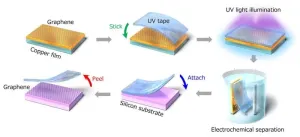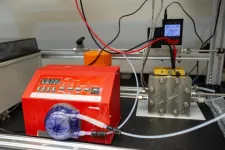Children's Hospital Colorado accepted as one of nine core sites nationally in the prestigious Pediatric Heart Network
Children’s Colorado’s Heart Institute gains research funding by the National Institutes of Health through 2031
2024-02-09
(Press-News.org)
Children’s Hospital Colorado (Children’s Colorado) is announcing its recent acceptance into the Pediatric Heart Network (PHN), a collective of leading hospitals working to improve outcomes and quality of life for children – and more recently adults – with heart disease. The hospital’s Heart Institute will become one of nine clinical research centers across North America selected to be a part of this national network.
“We are thrilled to be accepted as a new core site for the Pediatric Heart Network,” said Shelley Miyamoto, MD, professor and Jack Cooper Millisor Chair of Pediatric Cardiology and co-director of the Heart Institute. “As one of only eight stand-alone pediatric cardiology research centers in the country, we are uniquely positioned to ensure that children and young adults with heart disease in the Midwest and Rocky Mountain regions have equitable access to these important research studies.”
The goal of the PHN is to bring cutting-edge treatments, trials and studies to patients through the collaboration of the nine participating hospitals. Over the next seven years, the selected congenital heart centers will work together to conduct multisite research in pediatric and congenital heart disease projects, bringing even more leading and innovative trials, studies and treatments to patients treated at these sites.
Funded by the National Heart, Lung and Blood Institute of the National Institutes of Health (NIH), the PHN will provide $2.4 million over the term of the award to Children’s Colorado, which was selected as a core site in the Gateway to the West consortium with Washington University School of Medicine in St. Louis. As such, Children’s Colorado pediatric leaders will participate in all PHN-led clinical studies and serve on the executive committee and all other PHN committees.
The network aims to improve health outcomes in children with heart disease – particularly congenital heart disease –and more recently, in adults, by unifying an at-times fragmented congenital heart disease research community. Over the past 22 years, the multicenter collaborative effort has supported 25 large studies, including 10 clinical trials, adding treatments and improving care for pediatric heart disease patients.
The application process to be a part of the PHN is a competitive and rigorous endeavor that spanned six months. The application process began in January of 2023. Awardees had to demonstrate a strong institutional commitment to pediatric cardiovascular research and education, the infrastructure to participate and lead multicenter clinical trials, and a broad range of expertise among study team members. In addition, each site had to develop and pitch a study proposal, which is currently being considered for the next phase of clinical studies.
“We are confident that our exceptional outcomes and team members were key to securing this award,” Miyamoto said. “We are thrilled to be able to have even more collaboration and information from other PHN hospitals and to be able to offer even more valuable resources and options to our patients.”
Leading the new core site alongside Children’s Colorado’s Dr. Miyamoto is Emily Bucholz, MD, PhD, assistant professor of pediatrics and a fetal cardiologist, in collaboration with Washington University’s Andrew C. Glatz, MD, the Louis Larrick Ward Professor of Pediatrics, and Jennifer N. Silva, MD, a professor of pediatrics and of biomedical engineering. The two centers will work together as the Gateway to the West consortium, with regular virtual and in-person meetings, as well as a shared plan to enhance diversity in research participants, and a shared mentorship model to train the next generation of pediatric cardiology clinical investigators.
END
ELSE PRESS RELEASES FROM THIS DATE:
2024-02-09
Scientists have developed a new AI tool that maps the function of proteins in a cancerous tumour, enabling clinicians to decide how to target treatment in a more precise way.
In cancers such as clear cell renal cell carcinoma (ccRCC), responses to existing treatments are different for each patient, making it difficult to identify the right drug treatment regime for each patient.
For example, cancer therapeutic Belzutifan has recently been approved to treat ccRCC, but only has a response rate of 49% in patients with the most common form of the condition.
To understand better why some patients respond better than others, researchers from the Universities of Bath and Nottingham studied ...
2024-02-09
Asian Americans are less likely than their white peers to participate in health research involving MRIs and addressing this hesitancy could improve research, according to a Rutgers Health-led study.
Findings by the researchers, published in Alzheimer's & Dementia: Translational Research & Clinical Interventions, a journal of the Alzheimer’s Association, surveyed older adults about their experiences and perceptions of MRI brain imaging scans, their desire to learn results of scans and their attitudes related to dementia and overall research participation.
According to the study, South Asian older adults – those 65 and older – are less likely than older white adults ...
2024-02-09
Ordinarily, planets in evolved planetary systems, such as the Solar System, follow stable orbits around their central star. However, many indications suggest that some planets might depart from their birthplaces during their early evolution by migrating inward or outward. This planetary migration might also explain an observation that has puzzled researchers for several years: the relatively low number of exoplanets with sizes about twice as large as Earth, known as the radius valley or gap. Conversely, there are many exoplanets smaller and larger than this size.
“Six years ago, a reanalysis of data from the Kepler space telescope revealed a shortage of exoplanets with sizes around ...
2024-02-09
Fukuoka, Japan – Materials just atoms in thickness, known as two-dimensional (2D) materials, are set to revolutionize future technology, including in the electronics industry. However, commercialization of devices that contain 2D materials has faced challenges due to the difficulty in transferring these extremely thin materials from where they are made onto the device.
Now, a research team from Kyushu University, in collaboration with Japanese company Nitto Denko, have developed a tape that can be used to stick 2D materials to many different surfaces, in an ...
2024-02-09
Cosmic dust—like dust on Earth—comprises groupings of molecules that have condensed and stuck together in a grain. But the exact nature of dust creation in the universe has long been a mystery. Now, however, an international team of astronomers from China, the United States, Chile, the United Kingdom, Spain, etc., has made a significant discovery by identifying a previously unknown source of dust in the universe: a Type Ia supernova interacting with gas from its surroundings.
The study was published in Nature Astronomy on Feb. 9, and was led by Prof. WANG Lingzhi from the South America Center for Astronomy of the Chinese Academy ...
2024-02-09
Nearly 400 exceptionally well-preserved fossils dating back 470 million years have been discovered in the south of France by two amateur paleontologists. This new fossil site of worldwide importance has been analyzed by scientists from the University of Lausanne, in collaboration with the CNRS and international teams. This discovery provides unprecedented information on the polar ecosystems of the Ordovician period.
Paleontology enthusiasts have unearthed one of the world's richest and most diverse fossil sites from the Lower Ordovician period (around 470 million ...
2024-02-09
For millions of years, a variety of large herbivores, or megafauna, influenced terrestrial ecosystems. Among many others, these included elephants in Europe, giant wombats in Australia, and ground sloths in South America. However, these animals experienced a wave of extinctions coinciding with the worldwide expansion of humans, leading to dramatic but still not fully understood changes in ecosystems. Even the survivors of these extinctions strongly declined, and many are currently threatened with extinction.
While there are many case studies as well as theories about the effects of large animals, formal attempts to quantitatively synthesize their effects and establish ...
2024-02-09
The looming threat of climate change has motivated scientists worldwide to look for cleaner alternatives to fossil fuels, and many believe hydrogen is our best bet. As an environmentally friendly energy resource, hydrogen (H2) can be used in vehicles and electric power plants without releasing carbon dioxide into the atmosphere.
However, storing and transporting H2 safely and efficiently remains a challenge. Compressed gaseous hydrogen poses a significant risk of explosion and leakage, whereas liquid hydrogen must be maintained at extremely low temperatures, ...
2024-02-09
Immigrants living with dementia were more likely to present with agitation and aggression compared with their non-immigrant counterparts, a new study by Edith Cowan University (ECU) in collaboration with The Dementia Centre, HammondCare, found.
Researchers from ECU’s Centre for Research in Aged Care and HammondCare’s The Dementia Centre noted that behaviours and psychological symptoms of dementia (BPSD), such as agitation and aggression, are common; however, its presentation may be influenced by the cultural background of the person.
A study investigated differences in clinical and demographics characteristics ...
2024-02-09
Engineers at the University of Cincinnati created a more efficient way of converting carbon dioxide into valuable products while simultaneously addressing climate change.
In his chemical engineering lab in UC’s College of Engineering and Applied Science, Associate Professor Jingjie Wu and his team found that a modified copper catalyst improves the electrochemical conversion of carbon dioxide into ethylene, the key ingredient in plastic and a myriad of other uses.
Ethylene has been called ...
LAST 30 PRESS RELEASES:
[Press-News.org] Children's Hospital Colorado accepted as one of nine core sites nationally in the prestigious Pediatric Heart Network
Children’s Colorado’s Heart Institute gains research funding by the National Institutes of Health through 2031





